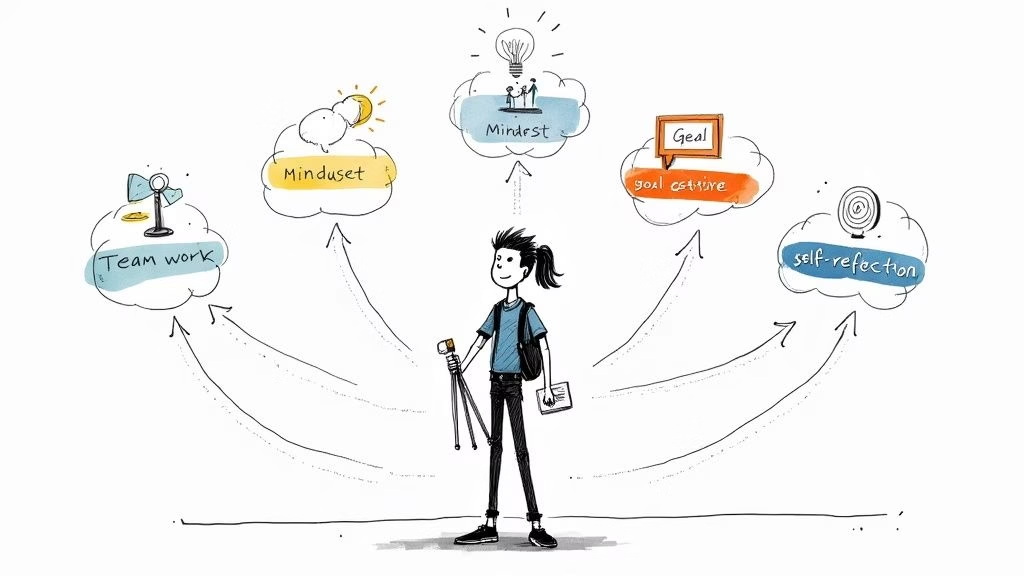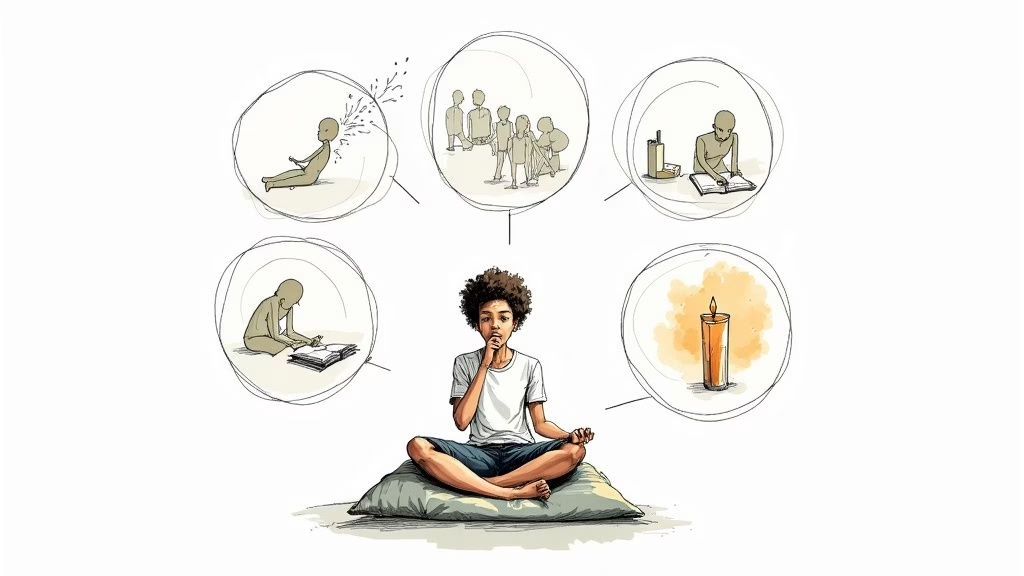Motivating a teenager can feel like an impossible puzzle. But the solution is often much simpler than we think: it’s about understanding their internal drivers, not forcing compliance.
Real, lasting motivation isn’t about rewards or punishments. It comes from finding personal meaning in a task and seeing growth as the goal. I only started to get motivated when I started trying to understand my own motivation. The easiest way is to tap into motivation for something else and try to use the same mindset for the task at hand. This is a mindset you can absolutely help your teen discover and apply to every part of their life.
Cracking the Code of Teen Motivation
Figuring out what makes a teenager tick often feels like a constant uphill battle. It’s easy to get caught in a frustrating cycle of nagging, bribing, and grounding, only to watch your teen shut down even more.
Here’s the thing: the problem usually isn’t laziness. It’s a disconnect. A lack of motivation is almost always a symptom of something deeper—feeling overwhelmed, fearing failure, or just not seeing the point of it all.
Instead of seeing it as defiance, try seeing it as a signal. This simple shift in perspective allows you to stop fighting for control and start nurturing a genuine, internal drive that will last a lifetime. To do this, we need to move past old-school parenting tips and embrace a more connected approach.
This table shows the shift I’m talking about:
The Shift from Old Tactics to a New Mindset
| Traditional Approach (Less Effective) | Modern Approach (More Effective) |
|---|---|
| Focuses on external rewards (grades, money). | Connects tasks to internal values and interests. |
| Uses punishment or threats to force action. | Fosters a sense of autonomy and choice. |
| Sees lack of motivation as laziness or defiance. | Views lack of motivation as a signal to investigate. |
| Emphasizes outcomes and performance. | Celebrates effort, progress, and learning from failure. |
| Imposes solutions and tells them what to do. | Collaborates on finding solutions and setting goals. |
Embracing the modern approach means you stop being the enforcer and start being the coach, guiding them toward their own sources of motivation.
Find Their Existing Motivation Blueprint
Think about what already grabs your teen’s full attention. Is it mastering a new level in a video game? Nailing a skateboard trick? Creating digital art for hours on end?
In these spaces, they are already motivation experts. They willingly push through failure, practice for hours, and feel a deep sense of accomplishment with every small win. This is their transferable motivation.
The goal isn't to pull them away from their passions. It's to help them recognize the feeling of success they get from those activities and apply that same energy to things that feel less exciting, like homework.
You could start a conversation like this: “I see how you never give up on that game until you beat the level. What’s going through your head when you do that? How could we bring that same energy to your math assignment?”
This approach validates their interests while teaching them a powerful life skill: understanding their own motivational triggers. It reframes chores and assignments not as burdens to be endured, but as new challenges to conquer. To really dig in, exploring some growth mindset activities for students can give you practical ways to help them see challenges as opportunities.
As you can see, tapping into a teen's internal sense of achievement and personal interests is far more likely to get lasting results than just leaning on grades or other external pressures.
Connecting Motivation to Teen Mental Health
When you’re trying to figure out how to motivate a teenager, it’s easy to get tunnel vision. You see the slipping grades, the unfinished chores, the lack of effort, and your first instinct is to fix the behavior. But what if the problem isn’t the behavior at all?
What I've learned from years of coaching is that motivation and mental health are deeply connected. A sudden drop in grades or a flat-out refusal to engage isn't always defiance. More often than not, it's a sign of a much deeper struggle. Overwhelming stress, anxiety, or depression can completely hijack a teenager's drive, making even small tasks feel monumental.
Before you can even think about building motivation, you have to create an emotionally safe foundation at home. That means shifting your focus from the symptom (the lack of motivation) to the source (what they're feeling). When a teen feels unheard or judged, they shut down. And when they shut down, real progress is impossible.
Recognizing When It's More Than Laziness
The world is a tough place for teens right now, and the numbers don't lie. The statistics on teen mental health paint a stark picture of the emotional weight many are carrying.
According to research from the CDC, the mental health crisis among adolescents is significant. In 2021, more than 4 in 10 students felt persistently sad or hopeless, and 1 in 5 seriously considered attempting suicide. These numbers are even higher for teen girls and LGBTQ+ youth.
These aren't just abstract numbers; they represent real kids in our homes and communities. When a teen is battling that kind of internal turmoil, homework and chores feel impossibly heavy. Their lack of motivation isn't a character flaw—it's a cry for help.
For a deeper look into the relationship between these challenges and motivation, our comprehensive guide on how to motivate teens offers additional strategies.
Creating a Safe Space for Conversation
So, how do you break through? The key is a gentle, non-judgmental approach. Your goal isn't to swoop in with solutions; it's simply to listen and validate their feelings.
Start by finding a low-pressure moment. A formal, face-to-face "we need to talk" session is usually a recipe for a shutdown. Instead, bring it up while you're driving, walking the dog, or just hanging out quietly together. The less direct eye contact, the better.
Here are a few ways to open the door:
- Observe and Inquire: "I've noticed you seem more withdrawn lately. I'm here for you if you want to talk about what's going on."
- Share Your Own Feelings: "Sometimes when I feel overwhelmed, I have a hard time getting anything done. I wonder if you ever feel that way."
- Validate Their Experience: If they do share something difficult, your response is crucial. Avoid the urge to fix it. Instead, say things like, "That sounds incredibly hard," or "It makes sense that you would feel that way."

The most powerful tool you have is your ability to listen without judgment. By simply holding space for their feelings, you signal that they are safe, valued, and not alone in their struggle.
To go a step further, you can introduce simple tools that help manage the underlying stress. Incorporating practices like mindfulness can make a huge difference in helping teens regulate their emotions and find their footing again. Exploring some mindfulness activities for mental well-being can provide practical tools for both of you.
By putting their mental health first, you create the fertile ground where motivation can finally begin to grow.
Navigating Procrastination and School Pressure

Once we see the link between motivation and mental health, it’s time to tackle the most common battleground: school. Procrastination isn't just laziness. Far from it. It’s a complex emotional response to pressure, boredom, or a deep-seated fear of not being good enough.
Many teens put things off because the task feels enormous and completely overwhelming. Others just don't see the point, viewing schoolwork as a meaningless hurdle to jump through. If you can get to the "why" behind their procrastination, you can shift from being an enforcer to a strategic ally in their corner.
Turning Overwhelm into Actionable Steps
The secret to breaking through procrastination is making the first step feel incredibly small and manageable. Big projects are paralyzing, but tiny tasks are not. This is where you can introduce some practical strategies to break that inertia.
Here are a few tactics I've seen work time and time again:
- The 10-Minute Rule: Make a deal to work on a dreaded task for just ten minutes. That's it. Often, just starting is the hardest part, and this tiny commitment can build enough momentum to carry them much further.
- Micro-Tasking: Break a huge project, like a research paper, into laughably small steps. Instead of "write the paper," the list becomes things like "find one source," "write the topic sentence," or "draft just one paragraph."
- Transferable Motivation: This is a real game-changer. I only began to understand my own drive when I analyzed what already motivated me. Help your teen connect the feeling of achievement they get from their hobbies to their schoolwork. Ask something like, "How can we make this history project feel more like beating a level in your favorite game?"
The easiest way to build momentum is to tap into motivation for something else and try to use the same mindset for the task at hand. It reframes the work from a chore to a challenge to be conquered.
Helping your teen master these skills now is a powerful lesson in self-management that will serve them for life. For more structured approaches, our guide on teenager time management can help build a solid foundation.
Looking Beyond the Household
Sometimes, a teen's lack of motivation is influenced by factors far beyond your control. The educational system itself can create immense pressure or, on the flip side, fail to provide the support needed, leaving students feeling completely disengaged.
It's a global issue. In 2021, over 259 million school-aged children and adolescents were out of school worldwide. In many countries, foundational literacy is a massive barrier, with up to 70% of 10-year-olds unable to read a simple sentence. While your teen’s situation may be different, these statistics highlight how educational gaps can crush academic motivation. You can discover more insights about these global youth challenges from pmnch.who.int.
This broader perspective helps shift the blame. It helps you see that your child's struggle might not be a personal failing but a very normal response to a flawed or overwhelming system. This understanding allows you to become their advocate, asking bigger questions about whether their school environment truly supports their unique learning style and well-being.
Helping Teens Find Purpose and Direction
Motivation isn't a switch you can just flip on. It has to come from somewhere deeper—a sense of purpose.
When a teenager can actually see how their algebra homework connects to their dream of designing video games, school stops feeling like a pointless chore. Suddenly, it’s a tool. The problem is, most teens see a massive canyon between what they’re genuinely interested in and the career paths they feel they should be chasing.
And let’s be honest, that pressure often comes from us, the parents, or from society in general. We want them to be successful, of course, but our definition of "success" doesn't always line up with what drives them. A teen who genuinely loves to create art might just shut down when pushed toward a "safer" career. It’s not defiance; it’s that the path feels completely meaningless to them.
Your job isn't to pick a path for them. It's to help them build a bridge between their interests and their future through low-pressure, curious exploration.
Making the Future Feel Real
The whole concept of a "future career" can feel abstract and seriously overwhelming to a teenager. The trick is to make it tangible and, dare I say, exciting. So instead of the classic, "What do you want to be when you grow up?" try exploring the possibilities with them.
Here are a few practical ways I’ve seen this work:
- Go down the YouTube rabbit hole for 'Day in the Life' videos. Seriously, this is a goldmine. Watching a graphic designer, a mechanic, or a nurse go through their actual workday can demystify a profession and spark real interest in a way a boring career pamphlet never could.
- Set up short informational interviews. Help your teen connect with someone in a field that seems cool to them. A quick, 15-minute chat with a family friend or neighbor about what they actually do all day can provide more genuine insight than hours of online research.
- Don't forget vocational programs. Not every path needs a four-year degree. Look into local trade schools or certification programs that align with their hands-on skills.
This process helps turn vague, faraway goals into something they can actually see and feel. For a more structured approach to this, our guide on goal setting for teenagers lays out a framework you can use together.
The goal isn’t to lock them into a career at 16. It's to show them that their interests have real-world value and that school is a stepping stone to a life they actually want to live.
This connection is so important, especially when outside pressures create a disconnect between a teen’s ambition and what they believe is possible. A 2022 survey found that 20% of teens globally want careers that require a degree but don’t actually expect to attend university. That number jumps to one-third for disadvantaged students. It’s a sobering reminder of how a teen's background can overshadow their true potential.
For some teenagers, purpose can be found in creative expression. Giving them space to explore that can be a game-changer. Checking out something like these inspiring art projects for high school students could be a great start.
By nurturing these little sparks of interest, you're helping them build a future that feels authentic, exciting, and, most importantly, theirs.
A Toolkit of Practical Resources for Families

Understanding what drives motivation is the first step, but having real tools to put into practice is where the change happens. This toolkit is full of practical resources for both you and your teen to manage stress, build resilience, and find support when it’s needed most.
These aren’t just abstract ideas. They’re actionable steps you can take today.
One of the best ways I've found to combat the overwhelm that kills motivation is mindfulness. It sounds simple, but even a few minutes of quiet focus can reset a stressed-out teenage brain. It improves their concentration and helps them regulate their emotions—skills that are crucial for just about everything.
A Simple Meditation Guide for Teens
Meditation doesn't need to be some complex, hour-long ritual. It can be incredibly simple. Here’s a straightforward guide you can share with your teen to help them get started:
- Find a Quiet Spot. Just sit comfortably somewhere you won't be interrupted for five minutes.
- Set a Timer. Start small—three to five minutes is perfect. Knowing there's an end point makes it feel way less intimidating.
- Focus on Your Breath. Close your eyes and just notice your breath. Feel the air moving in and out. Don't try to change it; just observe it.
- Acknowledge Wandering Thoughts. Your mind will wander. That’s what minds do. When you notice a thought, just gently acknowledge it and guide your focus back to your breath.
- Be Kind to Yourself. There’s no "perfect" way to do this. The real goal is just practicing how to return your focus, not to have a totally empty mind.
This simple practice builds the mental muscle for focus, which they can then apply to schoolwork, sports, or any other challenge that comes their way.
Resources for Teen Boys and Young Men
Teenage boys often face a unique set of pressures and can struggle to express what they’re feeling or ask for help. I’ve found that connecting them with positive male role models and supportive communities can be an absolute game-changer for their development and motivation.
A lot of boys find their drive by seeing what’s possible. When I started to understand my own motivation, I realized it came from seeing how my effort led to actual growth in things I cared about. That same mindset can be applied to anything.
Here are some resources specifically designed to support young men:
- Mentorship Programs: Organizations like Big Brothers Big Sisters are incredible. They connect boys with positive adult role models who can offer real-world guidance and support.
- Men's Groups: Groups like The Mankind Project's youth programs offer safe, structured environments for young men to explore challenges, build character, and connect with peers and mentors in a healthy way.
- Skill-Based Activities: Things like martial arts, team sports, or even coding clubs provide structure and a clear sense of accomplishment, often guided by a strong coach or instructor who can become a mentor.
Finding meaning in what you are doing and seeing growth as a good thing is the core of all motivation. Helping a teen boy find a mentor or a group where he can see that principle in action is one of the most impactful things you can possibly do.
Essential Mental Health Support for All Teens
Sometimes, a lack of motivation isn't just a phase—it's a clear signal that professional mental health support is needed. It’s so important to have reliable resources on hand so you can get your teen the help they deserve, right when they need it.
Here are a few trusted organizations that offer support, information, and crisis intervention:
- The National Alliance on Mental Illness (NAMI): NAMI offers a huge library of resources, support groups, and educational materials for both teens and their families.
- The Jed Foundation (JED): This organization is focused on protecting the emotional health of teens and young adults and preventing suicide.
- Crisis Text Line: This is a vital one to have saved. Teens can text HOME to 741741 from anywhere in the US to connect with a trained crisis counselor for free, 24/7 support.
Common Questions About Motivating Teens
Trying to understand what makes a teenager tick can feel like solving a puzzle. Let’s tackle some of the most common questions I hear from parents, reinforcing the core ideas we've talked about.
How Do I Motivate a Teen Who Seems Apathetic?
When a teen seems completely checked out, the instinct is to push them toward school or chores. Don't. Start smaller. Much smaller.
Your first job is to find a single spark of interest, no matter how trivial it might feel to you. Is it a video game? A specific artist? A creator they follow on YouTube? Whatever it is, lean into it with genuine curiosity, not judgment.
The goal isn't to get them passionate about algebra overnight. It's to help them remember what engagement feels like. I first started to grasp my own motivation by looking at what already held my attention. Help them connect the dots—show them how the focus they pour into their interests is a skill they can apply elsewhere.
It’s also important to know when apathy might be something more. Persistent indifference can be a sign of depression. You can gently open the door by saying something like, “I’ve noticed you seem a bit disconnected lately. I’m here if you ever feel like talking.”
What Is the Difference Between Helping and Nagging?
This one is simple, but it changes everything. The line between helping and nagging comes down to one core concept: autonomy.
Nagging is about control. It’s a top-down command focused on getting compliance. It’s often wrapped in judgmental language that puts your teen immediately on the defensive.
Nagging sounds like this:
- “Have you done your homework yet?”
- “You need to clean your room right now.”
- “Why do you always wait until the last minute?”
Helping, on the other hand, is about collaboration and support. You’re not taking over, you’re offering yourself as a resource.
Helping sounds like this:
- “What’s your plan for getting that history project done?”
- “Let me know if you need a hand with tidying up your space.”
- “How are you feeling about that deadline coming up?”
See the shift? You’ve moved from enforcer to supportive coach. You're acknowledging that it’s their responsibility, which respects their independence and actually helps build real, lasting motivation.
How Can I Connect With My Teen Son Who Refuses to Talk?
If you’re getting one-word answers to every question, it’s time to change your strategy. For many teenage boys, connection is built shoulder-to-shoulder, not eye-to-eye.
Instead of forcing a face-to-face conversation, invite him into a shared activity. Shoot some hoops, work on the car, play a video game he likes, or even just run errands together. These low-pressure environments make conversation feel natural, not forced.
And don’t forget the power of modeling. Boys learn how to express themselves by watching the men in their lives. When you share your own feelings in a healthy way—even something as simple as, “I had a really stressful day at work”—you’re giving him a blueprint for how to open up when he’s ready.
If you're looking for personalized strategies to help your teenager build lasting motivation and confidence, Andrew Petrillo Life Coaching offers one-on-one support tailored to their unique needs. Discover how we can help by booking a complimentary discovery call today. Learn more about my approach to teen coaching.




















